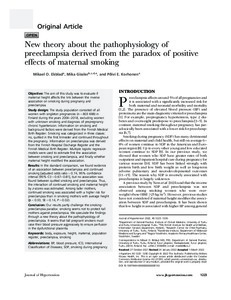New theory about the pathophysiology of preeclampsia derived from the paradox of positive effects of maternal smoking
Korhonen Päivi E; Ekblad Mikael O; Gissler Mika
https://urn.fi/URN:NBN:fi-fe2022081155142
Tiivistelmä
Objective: The aim of this study was to evaluate if maternal height affects the link between the inverse association on smoking during pregnancy and preeclampsia.
Study design: The study population consisted of all women with singleton pregnancies (n = 803 698) in Finland during the years 2004-2018, excluding women with unknown smoking and diagnosis of prepregnancy chronic hypertension. Information on smoking and background factors were derived from the Finnish Medical Birth Register. Smoking was categorized in three classes: no, quitted in the first trimester and continued throughout the pregnancy. Information on preeclampsia was derived from the Finnish Hospital Discharge Register and the Finnish Medical Birth Register. Multiple logistic regression models were used to estimate first the association between smoking and preeclampsia, and finally whether maternal height modified the association.
Results: In the standard comparison, we found evidence of an association between preeclampsia and continued smoking [adjusted odds ratio = 0.74, 95% confidence interval (95% CI) = 0.67-0.81], but no association was found between quitted smoking and preeclampsia. Thus, the interaction of continued smoking and maternal height by z-scores was estimated. Among taller mothers, continued smoking was associated with a higher risk for preeclampsia than in smoking mothers with average height (beta = 0.33, SE = 0.14, P = 0.02).
Conclusion: Our results partly challenge the smoking-preeclampsia paradox: smoking seems not to protect tall mothers against preeclampsia. We speculate the findings through a new theory about the pathophysiology of preeclampsia. It seems that tall pregnant smokers must raise their blood pressure aggressively to ensure perfusion in the dysfunctional placenta.
Kokoelmat
- Rinnakkaistallenteet [19218]
